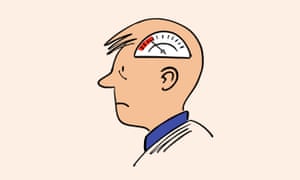What is depression?
Depressed people don’t all shuffle around with a long face, or cry at any provocation. MentalHealth.gov, a US government website, defines it as “losing interest in important parts of life”. Symptoms include eating or sleeping too much or too little; pulling away from people and usual activities; having low or no energy; feeling numb or like nothing matters; feeling unusually confused, forgetful, on edge, angry, upset, worried or scared; and thinking of harming yourself or others.
A visceral description is quoted by the UK campaign group Mind: “It starts as sadness, then I feel myself shutting down, becoming less capable of coping. Eventually, I just feel numb and empty.”
Depression is also often mixed with other health problems: long-term illness, anxiety, obsessive compulsive disorder or schizophrenia, for example.
The term dysthymia is also used for mild, long-term depression – usually lasting two years or more.
How many people have depression?
Clinical depression has surged to epidemic proportions in recent decades, from little-mentioned misery at the margins of society to a phenomenon that is rarely far from the news. It is widespread in classrooms and boardrooms, refugee camps and inner cities, farms and suburbs.
At any one time it is estimated that more than 300 million people have depression – about 4% of the world’s population when the figures were published by the World Health Organization (WHO) in 2015. Women are more likely to be depressed than men.
Depression is the leading global disability, and unipolar (as opposed to bipolar) depression is the 10th leading cause of early death, it calculates. The link between suicide, the second leading cause of death for young people aged 15-29, and depression is clear, and around the world two people kill themselves every minute.
While rates for depression and other common mental health conditions vary considerably, the US is the “most depressed” country in the world, followed closely by Colombia, Ukraine, the Netherlands and France. At the other end of the scale are Japan, Nigeria and China.
Why are there such wide variations?
The stark contrasts between countries have led some to dub depression as a “first world problem” or a “luxury”. The logic is that if you are staring down the barrel of a gun or you don’t know where the next meal is coming from, you have no time for such introspection.
Recent research points to myriad reasons, many overlapping: in particular less developed countries often lack the infrastructure to collect data on depression, and are less likely to recognise it as an illness. Also, people in these countries are more likely to feel a social stigma against talking about how they feel, and are reluctant to ask for professional help.
Statistics are also less simplistic than rich = depressed and poor = not depressed.
A paper in the journal Plos Medicine argues that, extremes aside, the majority of countries have similar rates of depression. It also found that the most depressed regions are eastern Europe, and north Africa and the Middle East; and that, by country, the highest rate of years lost to disability for depression is in Afghanistan, and the lowest in Japan.
What causes depression?
Things have improved since people with mental illness were believed to be possessed by the devil and cast out of their communities, or hanged as witches. But there remains a widespread misunderstanding of the illness, particularly the persistent trope that people with depression should just “buck up”, or “get out more”.

A contrasting opinion is provided by the psychiatrist Dr Tim Cantopher’s book Depressive Illness: The Curse of the Strong.
He argues there is a part of the brain called the limbic system that acts like a thermostat, controlling various functions of the body – including mood – and restoring equilibrium after the normal ups and downs of life. The limbic system is a circuit of nerves, transmitting signals to each other via two chemicals, serotonin and noradrenalin, of which people with depression have a deficit. According to this description, depressive illness is predominantly a physical, not mental, illness.
Cantopher says that, when under stress, weak or lazy people give in quickly; strong people keep going, redouble their efforts, fight any pressure to give up and so push the limbic system to breaking point. However, there is no scientific evidence to support this theory, as it is impossible to experiment on live brains.
Other commonly agreed causes or triggers are past trauma or abuse; a genetic predisposition to depression, which may or may not be the same as a family history; life stresses, including financial problems or bereavement; chronic pain or illness; and taking drugs, including cannabis, ecstasy and heroin.
The subject of much debate, there is a school of thought that severe stress or certain illnesses can trigger an excessive response from the immune system, causing inflammation in the brain, which in turn causes depression.
Treatments
The WHO estimates that fewer than half of people with depression are receiving treatment. Many more will be getting inadequate help, often focused on medication, with too little investment in talking therapies, which are regarded as a crucial ally.
Among pharmacological treatments for depression, the most commonly prescribed antidepressants are selective serotonin re-uptake inhibitors (SSRIs) which reduce the absorption of serotonin, increasing overall levels. Another popular class of drugs is serotonin norepinephrine re-uptake inhibitor (SNRIs), which work on both serotonin and noradrenaline.
The most common talking therapy is cognitive behavioural therapy, which breaks down overwhelming problems into situations, thoughts, emotions, physical feelings and actions to try to break a cycle of negative thoughts.
Other types are interpersonal therapy, behavioural activation, psychodynamic psychotherapy and couples therapy. All talking therapies can be used on their own, or with medication.
Away from the medical approach, doctors can prescribe physical activity or arts therapy, while some patients opt for alternative or complementary therapies, most popularly St John’s Wort herbal pills, mindfulness and yoga.
Trends
While there are more and more treatments for depression, the problem is rising, not falling.
From 2005-15, cases of depressive illness increased by nearly a fifth. People born after 1945 are 10 times more likely to have depression. This reflects both population growth and a proportional increase in the rate of depression among the most at-risk ages, the WHO said.
Suicide rates, however, have declined globally, by about a quarter. In 1990, the rate was 14.55 per 100,000 people, in 2016 the rate was 11.16 per 100,000.
A key reason for the continuing rise in depressive illness is that drugs do not necessarily “cure” the patient, and other therapies that can make the crucial difference are usually not in sufficient supply.
Other reasons given for the continuing rise in depressive illness include an ageing population (60- to 74-year-olds are more likely to suffer than other age groups), and rising stress and isolation.
What next?
No new antidepressant drugs have been developed in the last 25 years, forcing psychiatrists to look elsewhere for help.
There have been positive experiments with both ketamine and psilocybin, the active ingredient in magic mushrooms. Further hopes for a new generation of treatments have been raised by recent discoveries of 44 gene variants that scientists believe raise the risk of depression. Another controversial area of research is treatment for low immunity and mooted links between depression and inflammation.
Countries are increasingly recognising the need to train more psychologists to replace or complement drug treatments.
And perhaps most importantly, there is a cultural movement to make it easier for people to ask for help and speak out about their illness.
Some of the most visible leaders of this shift are the UK’s princes William and Harry, who set up the charity Heads Together and have talked publicly about their own problems. Others are celebrities; most recently the wrestler and actor Dwayne “The Rock” Johnson has spoken about his depression, and the singer Mariah Carey has talked about having bipolar disorder.
Further reading
Personal stories of depression from mental health charity Mind
World Health Organisation report
MentalHealth.gov, for wider information on mental health
Country and regional statistics from Plos Medicine Journal
All Kinds of Minds TED Talks
Tim Cantopher: Depressive Illness, the Curse Of the Strong

